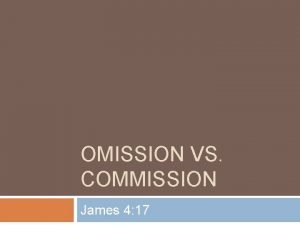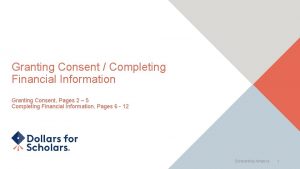Temporary polling omission in adaptive polling and granting




![Proposed Text [Add new subclause 15. 2. x , Advanced scheduling services] ------------------- Start Proposed Text [Add new subclause 15. 2. x , Advanced scheduling services] ------------------- Start](https://slidetodoc.com/presentation_image_h2/c3c3e8d29aa1112010e647de2753ecc1/image-5.jpg)
- Slides: 5

Temporary polling omission in adaptive polling and granting for the IEEE 802. 16 m Amendment IEEE 802. 16 Presentation Submission Template (Rev. 9) Document Number: IEEE C 802. 16 m-09/0632 Date Submitted: 2009 -03 -02 Source: Keiichi Nakatsugawa, Masato Okuda E-mail: Nakatsugawa@jp. fujitsu. com Fujitsu *<http: //standards. ieee. org/faqs/affiliation. FAQ. html> Venue: Call for Contributions on the Project 802. 16 m Amendment Working Document (AWD) Content (80216 m-09_0012. pdf) Base Contribution: N/A Purpose: Propose to adopt 802. 16 m Amendment Working Document (AWD). Notice: This document does not represent the agreed views of the IEEE 802. 16 Working Group or any of its subgroups. It represents only the views of the participants listed in the “Source(s)” field above. It is offered as a basis for discussion. It is not binding on the contributor(s), who reserve(s) the right to add, amend or withdraw material contained herein. Release: The contributor grants a free, irrevocable license to the IEEE to incorporate material contained in this contribution, and any modifications thereof, in the creation of an IEEE Standards publication; to copyright in the IEEE’s name any IEEE Standards publication even though it may include portions of this contribution; and at the IEEE’s sole discretion to permit others to reproduce in whole or in part the resulting IEEE Standards publication. The contributor also acknowledges and accepts that this contribution may be made public by IEEE 802. 16. Patent Policy: The contributor is familiar with the IEEE-SA Patent Policy and Procedures: <http: //standards. ieee. org/guides/bylaws/sect 6 -7. html#6> and <http: //standards. ieee. org/guides/opman/sect 6. html#6. 3>. Further information is located at <http: //standards. ieee. org/board/pat-material. html> and <http: //standards. ieee. org/board/pat >.

Adaptive polling and granting • To provide efficient UL resource allocation, “Adaptive polling and granting” was adopted in the SDD. (SDD) 10. 2 Adaptive polling and granting IEEE 802. 16 m supports adaptation of service flow Qo. S parameters. One or more sets of Qo. S parameters are defined for one service flow. The AMS and ABS negotiate the supported Qo. S parameter sets during service flow setup procedure. When Qo. S requirement/traffic characteristics for UL traffic changes, the ABS may autonomously switch the service flow Qo. S parameters such as grant/polling interval or grant size based on predefined rules. In addition, the AMS may request the ABS to switch the Service Flow Qo. S parameter set with explicit signaling. The ABS then allocates resource according to the new service flow parameter set. • ABS (or AMS) may switch grant/polling interval or grant size based on UL traffic characteristics. e. x. ) In Vo. IP traffic case, ABS may extend polling interval when it detects the silent period. →What else is the usage case?

(Informative) Qo. S parameters for rt. PS in 16 e • For example, rt. PS in 16 e has following Qo. S parameters: – Minimum Reserved Traffic Rate – Maximum Sustained Traffic Rate • Peak information rate of the service. At the BS and SS, the service shall be policed to conform to this parameter, on the average, over time. – – Maximum Latency Uplink Grant Scheduling Type Request/Transmission Policy Unsolicited Polling Interval • BS periodically allocates UL request grant (6 byte) at this intervals.

Temporary polling omission at max rate transmission • In the case of burst data traffic, requested UL BW increase instantly. Due to BS scheduling, UL BW allocation is reached at Max. Sustained Traffic Rate and spans adjacent frames for a while. →In such conditions, polling is unnecessary and can be omitted, ABS can allocate UL data grant directly (same as UGS manner). UL BW Generated UL burst data in MS (ex. )200 kbyte BS monitors actual transmitted traffic rate. If actual transmitted traffic rate already reaches Max. Sustained Traffic Rate and queued BW request size is large enough (compared to the Max. Rate), then BS omits polling for certain period/times and allocate UL data grant directly. UL data grant without polling/BW request Max sustained traffic rate (ex. . 5 Mbps= 25 kbit/frame) BW Req. (ex. 50 kbyte/each) Allocated UL BW (ex. ) 25 kbit x 64 frames time Polling (ex. 10 msec) Polling omission (for saving UL resources) Example of UL burst data generation and BW allocation
![Proposed Text Add new subclause 15 2 x Advanced scheduling services Start Proposed Text [Add new subclause 15. 2. x , Advanced scheduling services] ------------------- Start](https://slidetodoc.com/presentation_image_h2/c3c3e8d29aa1112010e647de2753ecc1/image-5.jpg)
Proposed Text [Add new subclause 15. 2. x , Advanced scheduling services] ------------------- Start of the Text -------------------15. 2. x Advanced scheduling services 15. 2. x. x Adaptive polling and granting One or more sets of Qo. S parameters are defined for one service flow. The AMS and ABS negotiate the supported Qo. S parameter sets during service flow setup procedure. When Qo. S requirement/traffic characteristics for UL traffic changes, the ABS may autonomously switch the Qo. S parameter set based on predefined rules. For example, when the Qo. S parameter set 1 for rt. PS is being used, actual transmitted traffic rate is reached at Maximum Sustained Traffic Rate parameters, ABS may switch the Qo. S parameter set to set 2 for UGS and allocate UL data grant without polling/bandwidth request. In addition, the AMS may request the ABS to switch the Qo. S parameter set with explicit signaling. The ABS then allocates resource according to the switched Qo. S parameter set. ------------------- End of the Text ------------------- • References [1] IEEE 802. 16 m-08/003 r 7, “IEEE 802. 16 m System Description Document”








